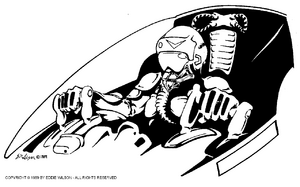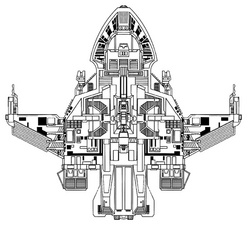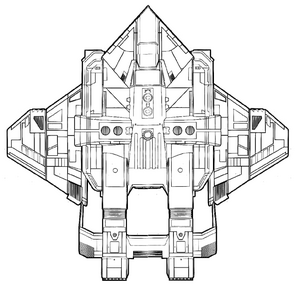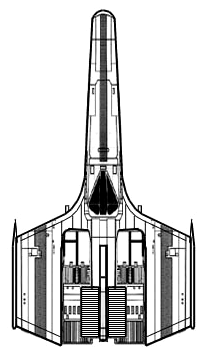Starflight: Starfighters in Alpha Dawn
From Star Frontiers Network
m (→New Weapons: Moved "Bomb Launcher" description.) |
m (→New Weapons: spacing) |
||
| Line 326: | Line 326: | ||
the Weapons Table shows what they can be attached to, | the Weapons Table shows what they can be attached to, | ||
but may require penalties (Referee's discretion). | but may require penalties (Referee's discretion). | ||
| + | |||
| + | |||
{| style="width:100%; padding-right:10px; padding-top:10px; padding-bottom:10px; padding-left:10px;" | {| style="width:100%; padding-right:10px; padding-top:10px; padding-bottom:10px; padding-left:10px;" | ||
| Line 449: | Line 451: | ||
* Guided missiles are guided by the onboard computer that has locked onto a target (must have Target Tracker or better). | * Guided missiles are guided by the onboard computer that has locked onto a target (must have Target Tracker or better). | ||
* Hard Lock missiles have both infrared and guided capabilities along with "last known position" capability. They are slightly larger than other missiles. (-1 to the maximum number of missiles allotted to the fighter in the Armament Table for every 1-3 Hard Lock missiles added.) | * Hard Lock missiles have both infrared and guided capabilities along with "last known position" capability. They are slightly larger than other missiles. (-1 to the maximum number of missiles allotted to the fighter in the Armament Table for every 1-3 Hard Lock missiles added.) | ||
| + | |||
| + | |||
{| style="width:500px; padding-right:10px; padding-top:10px; padding-bottom:10px; padding-left:10px;" | {| style="width:500px; padding-right:10px; padding-top:10px; padding-bottom:10px; padding-left:10px;" | ||
Revision as of 15:08, 31 October 2012
Top:Star Frontiersman main page | Up: Star Frontiersman Issue 5 main index | Up: New Rules main index
| This article has been specially edited by the author for Star Frontiers Network to include updates from the Stellar Errata of Starfrontiersman Issue #7 and the specially requested Hard Lock Missile and Mini-rockets. Other changes include the Weapon Modifications rule, step-by-step construction guidance and examples, and clarifications of definitions.
Remember, though this article focuses on fighters, these rules can also be used for normal vehicles. |
One of the most enjoyable sci-fi elements is when the heroes strap into small fighters and fly out to perform dangerous missions and combat. This aspect of the sci-fi hero seems to have been almost entirely overlooked in Star Frontiers—until now.
The uniqueness of different types of fighters and how they’re equipped is sadly missing from the game. The only thing differentiating them in Knight Hawks was whether they were civilian or military. Then articles came along that gave more weapons and defensive options, but still the variety was stale. In fact, in previous information we are counseled not to even use fighters. So what was the point in including them in the first place?
In order to make space fighters usable and more unique, one from the other, and to make space combat possible for these small vessels, fighter vs. fighter, we must look to the smaller combat scale of the Alpha Dawn vehicle rules system and analyze how fighters can be used.
For this system, the space fighters and shuttles have been reclassified as vehicles, instead of spaceships, as they are little more than cloud flyers with minor modifications for space travel. A fighter has very few gauges that can be found on most space ships.
Other treats in this article include more weapons available for fighters and aerospace vehicle system packages.
Though this article focuses on fighters, feel free to use this information to design your own aerospace vehicle. There’s even information here that can be used for ground vehicles.
The Knight Hawks rules prove particularly ineffective for space units of size 1 and 2. The smaller the craft, the less relevant the spaceship stats prove to be. As it is, they are just relevant enough for the Assault Scout, but for nothing smaller.
To remedy this, these vehicle rules are being extended in this article to units of hull size 2 or less. A whole different scale of damage applies that is not as extreme as large spaceship damage.
The vehicles, weapons, defenses, and equipment in this article are by no means exhaustive, but contain all the items this author feels worth use from previous articles and new creations. Most items from other materials are not included here, but are useable with this system.
| Frame Size (KH) | Mass in kg | Engine size |
| F1 (HS1) | <50 | Standard |
| F2 (HS1) | <100 | Standard |
| F3 (HS1) | <200 | Standard, A1* |
| F4 (HS1) | <500 | A1 |
| F5 (HS1) | <1000 | A1 |
| F6 (HS1) | <2000 | A1 |
| F7 (HS1) | <5000 | A1, A2* |
| F8 (HS1) | <10,000 | A1, A2* |
| F9 (HS2) | <20,000 | A2 |
| F10 (HS2) | <50,000 | A2 |
| F11 (HS2) | <100,000 | A2 |
| F12 (HS2) | <200,000 | A2 |
| * Single engine design only. | ||
Contents |
Fighter Construction
To start, choose the aerospace fighter type from the descriptions below, then look on the Available Fighters Table to determine the size ranges for that fighter type in the first column and write down the rest of the information on the row for that fighter. Then note the engine size available for your craft from the Engine Table and choose your engine type, noting the information on your record sheet. Work with your referee to determine the final value of variant numbers, including cost.
Aerospace Fighter Types
Besides the vehicles in the Alpha Dawn rules, more flying vehicles may now be available. These types are defined below. As you read them, enjoy the various fighter types that are graphically represented with each description.
Mini-flyers

| |||
| Pendulum | Lantern | Jaunt | Perilous |
Little more than an air-bubble with a ramjet engine attached, the mini-flyer is able to reach high altitude space stations from a planet’s surface, but does not have the capability to escape a planet’s gravity without breaking apart. Miniflyers cannot have any defenses and will only fit laser pods and mini-rockets. They can only hold a single passenger (the pilot) and have limited cargo capacity, such as for a tool kit and change of clothes. The low cost helps keep them viable, and surprisingly popular for personal transportation to and from orbital stations and high altitude launch platforms.
Personal Fighters

| |||
| Stylus | Hunter | Regent | Dijack |
Personal fighters are often better armed than Cloud Flyers, but can only carry up to 2 people. Personal fighters have no bombing capability or armor to speak of, but their teeth can be nasty. Able to carry small assignments of piston and pod weapons, assault rockets, or missiles, personal fighters are the vehicle of choice for the more discriminating adventurer. They cannot carry bombs. Careful, though, these aren’t meant for war. Pirates often take on such vehicles and their pilots for a split of the booty, as a private air force is invaluable to commandeering civilian ships. They also prove invaluable for defending civilian ships.
Military Fighters

| |||
| Dark Hawk | Blade | Ripper | Black Dart |
You won’t find these for private sale, as they contain armor and advanced defenses for large scale skirmishes. Even black market traders know that private citizens can’t be trusted with these weapons of mass destruction. No, they want them sold to the highest bidder in the largest quantity. The military fighter is heavy duty in both fire power and defenses and are built with armor standard. Even though military fighters have limited bombing payload capacity, if any, military fighters are ten times more effective than personal fighters. These are often granted under special permission to Privateers, though common pirates tend to get a hold of them by raiding small military convoys.
Military Bombers
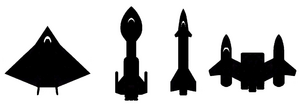
| |||
| Reaper | Trapper Arc | Clear Cutter | Massacre |
Often 2-4 times the size of most military fighters, military bombers carry many times more the payload of any fighter and are also armored. These are highly specialized killing machines capable of toppling large building complexes, flattening settlements, sinking sea carriers, and crippling or even destroying large space vessels when grouped with other bombers. Bombers all require a minimum of two crewmen (pilot and copilot/navigator) and are extraordinarily durable. (Bombers are technically Hull Size 2 from Knight Hawks rules)
Size
Though actual vehicle classes are often dependent on area, mass, and even shape altogether to determine size, to keep things simple, a new size rating (as opposed to the KH size system) is given for vehicle types relying on the vehicle’s base mass instead of its length. The frame sizes are listed as F1, F2, F3, F4, etc. The cargo weight and weapons do not affect the vehicle’s size, but the engines and computer systems do. The Vehicle Frame Size Table lists the frame sizes with compatible engine sizes. You can either have single engines or dual engines. "Standard" engines refer to small rich-mixture engines that can be either atmospheric ramjet, trans-atmospheric pion or space-only colloid thrusters (Chemical).
| Fighter Type* | Size (KH) | PN | ADF/MR | ADM | Cargo Limit | VSP | Cost** |
| Mini-flyer | 3 (1) | 1 | 6 | -1 | 400kg/4m3 | 10+d10 | >40,000Cr |
| Personal | 4-5 (1) | 1-2 | 6 | 0 | 8,000kg/12m3 | 20+d10 | >55,000Cr |
| Light Military | 6-7 (1) | 1-2 | 5 | +1 | 16,000kg/18m3 | 40+d10 | >65,000Cr |
| Heavy Military | 7-8 (1) | 2-4 | 5 | +1 | 22,000kg/26m3 | 45+d10 | >80,000Cr |
| Light Bomber | 8-9 (2) | 2-8 | 5 | +2 | 55,000kg/38m3 | 45+d10 | >105,000Cr |
| Heavy Bomber | 10-11 (2) | 2-12 | 5 | +2 | 100,000kg/50m3 | 50+d10 | >120,000Cr |
| * Ordered according to size | |||||||
| ** Costs are for empty structure only; it does not include equipment. | |||||||
New Engines
| Engines | Ramjet | Chemical | Plasma | After Burner |
| Size “A1” | ||||
| Fuel Cost | 20xFrame | 10xFrame | 10xFrame/2 | +10** |
| Prog. Level | 1 | 1 | 3 | 1 |
| Fnctn Pnts | 2 | 3 | 14 | 1 |
| Cost* | 8,000Cr | 20,000Cr | 55,000Cr | 5,000Cr |
| Size “A2” | ||||
| Fuel Cost | 40xFrame | 20xFrame | 10xFrame/4 | +20** |
| Prog. Level | 1 | 1 | 4 | 1 |
| Fnctn Pnts | 2 | 3 | 14 | 1 |
| Cost* | 15,000Cr | 30,000Cr | 100,000Cr | 10,000Cr |
| * Engine, installation and program costs per engine. | ||||
| ** Add this modifier to your fuel cost. | ||||
What is not generally known is that small craft of size 2 or smaller maneuver by means of colloid thrusters (a type of miniature electrostatic ion thruster) which are built into the frames. These work independently of the ship’s engines, though may derive their power from the engines. Because they are built into the aerospace vehicle, they are not a concern when choosing an engine for your craft.
Along with the new scale for fighters are new engine classifications. Engine size A1 is for Knight Hawks hull size 1, and engine size A2 is for Knight Hawks hull size 2 (See the Vehicle Size Table above for fighter size assignments).
Ramjet Engine. These are not as efficient as other engines and are useless for space flight because of their need for air flow. Though they are less expensive to purchase and install, they are more expensive to maintain and keep fueled (they use much more fuel than other engines and require more maintenance).
Plasma Drive. In addition to rocket boosters and atomic engines, there is also the more expensive plasma drive. A plasma drive is considerably safer, more compact, and easier to find, but much more expensive than an atomic drive. Plasma power is achieved by pulling radiant atoms apart through ionization instead of colliding them. Additionally, plasma drives have virtually 0 radiation emissions. They are the most efficient for inner-system travel. These can be sized to fit on any size of craft.
These are the small thrusters you see on many of your favorite space fighters. They are low maintenance, highly efficient, and ideal for relatively comfortable high speed launches, as their thrust requires building, easing into the launch speed. Their big brothers that we’ve come to know simply as Ion Drives, use particle acceleration which can cause a craft to approach the speed of light.
After Burner. This injects fuel directly into the ignited exhaust (“after” the engine), causing the vehicle to increase its acceleration beyond its standard acceleration. This can be useful for escaping an enemy, catching up to an enemy, or getting that extra burst for escaping atmosphere. However, this is an extremely inefficient expenditure of fuel, so use it wisely. This is available for any engine planet-side or in space.
Weapons
Now that you have your new fighter, choose your weapons, if any. While keeping the restrictions of the Armament table in mind, choose your fighter's weapons from the Weapons Table, recording their stats on your fighter's vehicle record sheet. Reference the Missiles Table and the Weapons Chance to Hit Table for combat.
New Weapons
Normal weapons have been thoroughly covered in other articles, so we will only discuss new weapons for aerospace vehicles here.
Previous board game and miniatures rules only provided assault rockets to fighters, and mounted laser pods were provided in the Polyhedron #19 article, Laser Pod, by John Pickens and laser pistons, maxi-missiles and fusion bombs were provided in the Dragon Magazine, November 1986, article, An Interstellar Armory by Gus Monter. Now prepare yourself for several new additions.
All weapons listed in the Armament Table are considered externally attached, except for bombs and starbursts, and has no bearing on space. A fighter can carry all the weapons listed on its row at the same time. Meaning that a Light Military Fighter of F7 can carry 8 missiles, 4 bombs, 4 starbursts, 1 Assault Rocket, and any one of the four beam or P.G.S. weapons. Of course this all depends upon the fighter's design and Referee's allowance. The discrepancy between the qualifying frame size of the Dual Piston and Bolt Launcher of the Armament Table and the Minimum Vehicle Size of the same weapons on the Weapons Table are due to that the Weapons Table shows what they can be attached to, but may require penalties (Referee's discretion).
| Fighter | Missiles | Bombs | Starbursts | Assault Rockets | Laser Pod | Laser Piston | Dual Piston | Bolt Launcher |
| Mini-flyer | 0 (8*)** | 0 | 0 | 0 | X | |||
| Personal | 2-6** | (2)** | 1-2 | 0 | X | X | V Size 5 | |
| Light Military | 2-8 | 2-4 | 1-4 | 1 | X | X | V Size 7 | X |
| Heavy Military | 2-12 | 2-8 | 1-8 | 2 | X | X | X | X |
| Light Bomber | 2-14 | 1-15 | 1-12 | 3 | X | X | X | X |
| Heavy Bomber | 4-20 | 1-30 | 1-12 | 5 | X | X | X | X |
| * Mini-flyers can load up to 8 mini-rockets. | ||||||||
| ** Though not legally permitted for civilian vehicles, personal fighters may still be adapted to arm these weapons. | ||||||||
